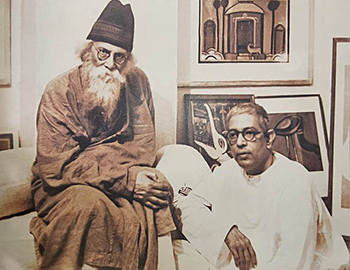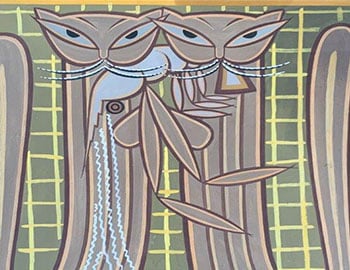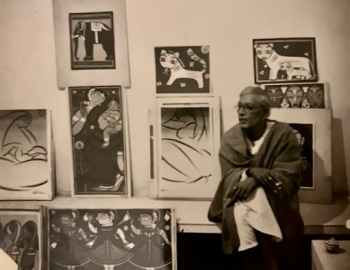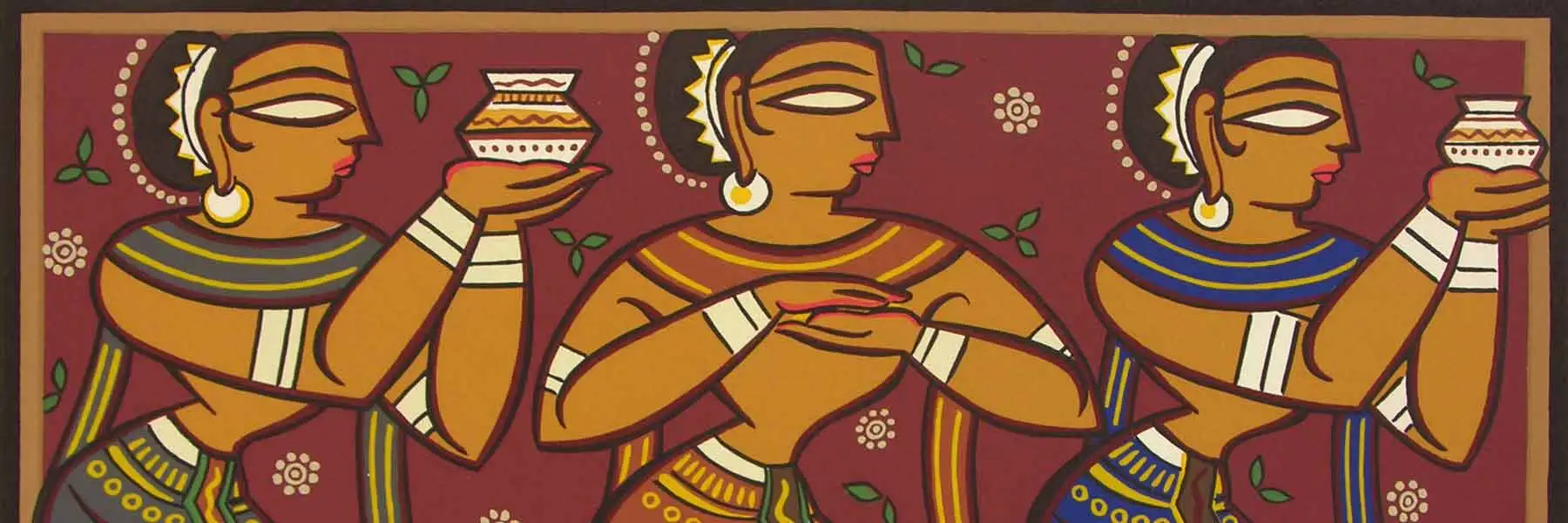
ORIGINAL ART BY JAMINI ROY: PAINTINGS FOR SALE
Please hover or click on images to view artwork details.
ORIGINAL ART BY JAMINI ROY: PAINTINGS SOLD
Please hover or click on images to view artwork details.
ART BY JAMINI ROY: SERIGRAPHS (PRINTS) FOR SALE
Please hover or click on images to view artwork details.
JAMINI ROY ART INSTALLATIONS AT CLIENTS' HOMES

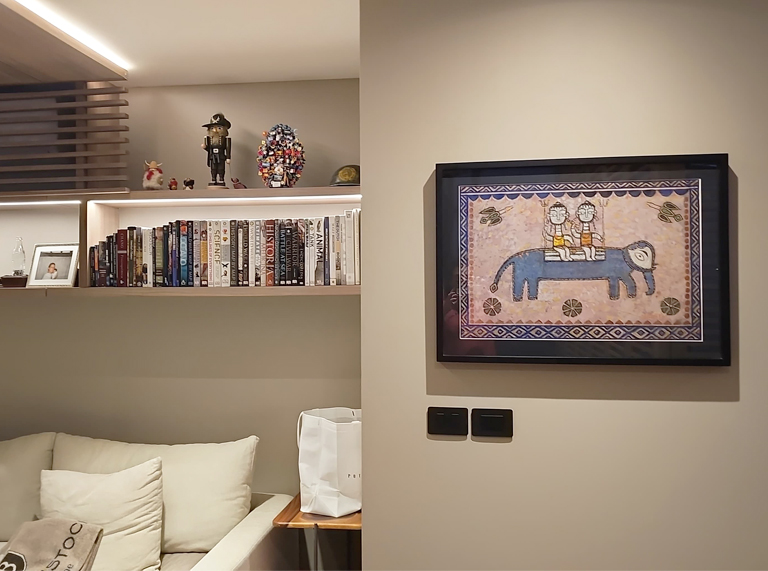



JAMINI ROY BIOGRAPHY

Art by Jamini Roy brought together multiple Indian influences, such as the thin brushstrokes of bazaar paintings sold outside the Kalighat temple and design elements from the terracotta reliefs on the Bishnupur temples. His paintings often featured borders and other classic decorative patterns of traditional Indian art. Working in an earthy color palette of rusty reds, golden yellows and turquoise blues, Jamini Roy typically depicted religious themes, such as Radha, as well as scenes of daily life, such as mother and child or animals. He also frequently depicted the Santhals, a large tribe living in eastern India.
Born in 1887 in a small village in West Bengal, artist Jamini Roy studied at the Government School of Art in Kolkata in the early 1900s. He was one of the most famous pupils of Abanindranath Tagore, who led the Bengal School of Art and greatly influenced the development of a national Indian style. Jamini Roy’s work has been exhibited in distinguished international institutions such as Kiran Nadar Museum of Art, National Gallery of Modern Art in New Delhi, Philadelphia Museum, Rubin Museum of Art and San Jose Museum of Art. He was honored with the Padma Bhushan in 1954 and became the first Fellow of the Lalit Kala Akademi in 1955. He passed away in 1972 in Kolkata, where he had lived throughout his adult life. Shortly after, in 1976, his works were declared among the “Nine Masters” by the Indian Government’s Ministry of Culture, to be heralded as “art treasures, having regard to their artistic and aesthetic value.”
You are welcome to buy artist Jamini Roy’s fine art prints online or view them at our gallery in Palo Alto (San Francisco Bay Area). All serigraphs are numbered and come with a certificate of authenticity.
LATEST BLOGS
FEATURED VIDEO
A step-by-step demonstration of the serigraphic printing process.
BUILDING YOUR ART COLLECTION: ESSENTIAL FAQS ABOUT JAMINI ROY
When and where was artist Jamini Roy born?
Jamini was born in the Bankura district of West Bengal on April 11, 1887.
What are the main themes in Jamini Roy’s artworks?
Jamini primarily depicted everyday life in rural India, from the people like drummers, dancers and merchants to the animals like horses and cats. He also frequently depicted the indigenous Santhal tribe, stories from Indian mythology such as Krishna-Leela and the Ramayana, and Christian imagery.
How did Jamini’s personal beliefs and philosophy reflect in his art?
Jamini firmly believed that art should be accessible to all. He once said, “Instead of hanging calendars in the walls of homes, let them hang a pat painted by me.” In order to keep his prices affordable, he used inexpensive materials and duplicated compositions with slight variations on colors and details.
What was Jamini like as a person?
Jamini took pride in his roots in West Bengal. He championed the importance of connecting to one’s culture, and he valued simplicity, in both life and in art. For more personal insights into Jamini, read this guest post on our blog, written by one of his former students.
What awards and honors did Jamini Roy receive during his lifetime?
Jamini received the prestigious Padma Bhushan (the third-highest civilian honor) from the Government of India in 1955, and he was elected as a fellow of Lalit Kala Akademi in 1956. In 1976 after his passing, the Government of India declared his artworks a ‘National Treasure,’ naming him among the revered Nine Gems.
What are some notable international exhibitions of Jamini Roy?
During his lifetime, although he personally never traveled outside of India, there were significant international exhibitions of Jamini’s work in galleries in London in 1946 and New York in 1953 and 1957. He also exhibited at the National Gallery of Art in Washington, DC in 1956. Since his death, his work has traveled to reputed museums and venues such as the Philadelphia Museum of Art, the Rubin Museum of Art in New York, the San Jose Museum of Art, Victoria and Albert Museum in London, and the Venice Biennale.
To learn more about his life, read our blog about unknown facts about artist Jamini Roy.
FREQUENTLY ASKED QUESTIONS
Can you help source original artwork by Jamini Roy?
Yes, in addition to our collection of serigraphs, we do sell original paintings by Jamini Roy.
What is a serigraph?
Serigraphs are a type of high quality, limited edition screen print made on high quality paper in collaboration with the artist. Each print is numbered.
To learn more, read our blog on collecting serigraphs.
What is the serigraphic printing process?
Producing serigraphs is a meticulous, completely manual process. Using the original artwork as the master guide, a different stencil is created for each color that will compose the image. Then, the ink is pushed through the corresponding stencil onto the paper and then laid flat on a drying rack. This step is repeated multiple times, using a separate stencil for each color. A single serigraphic print can have as many as 25 colors or more.
Are the serigraphs signed?
All serigraphs by Jamini Roy are numbered and come with a certificate of authenticity. Please note these prints are not hand signed by the artist; they were produced in collaboration with his family after his death.
Are fine art prints a good investment?
Yes, the value of a serigraph can keep increasing with time, depending on the artist’s historical importance and the specific serigraph.
Is shipping available worldwide?
Yes, we offer both domestic and international shipping, and all fees are calculated upon purchase and included on your invoice. We frequently ship throughout the US as well as to Europe, Africa and Asia.
Are the artworks framed?
No, neither the paintings nor serigraphs are sold framed. While it is not necessary to frame a canvas, it can be a stylistic choice and help integrate the painting with the existing decor. Meanwhile, works on paper must always be framed to properly protect them from warping and discoloration. You can read more advice about framing paintings and framing fine art prints on our blog.
How should the artwork be taken care of?
As a resource for clients, we have written a guide on the best art care tips for works on paper.

